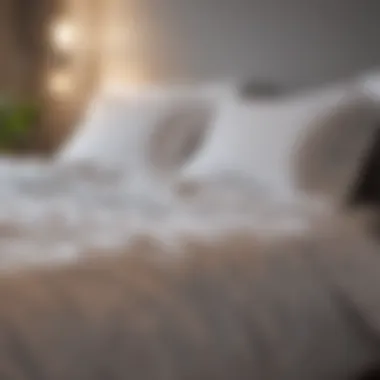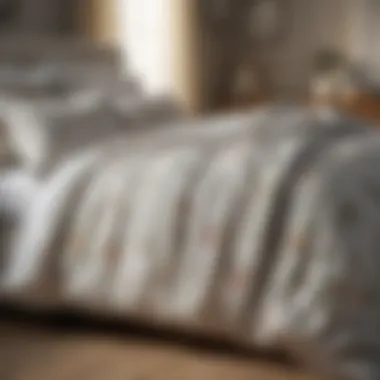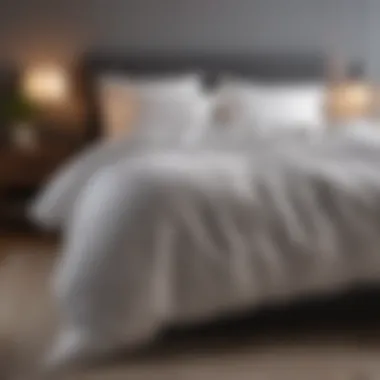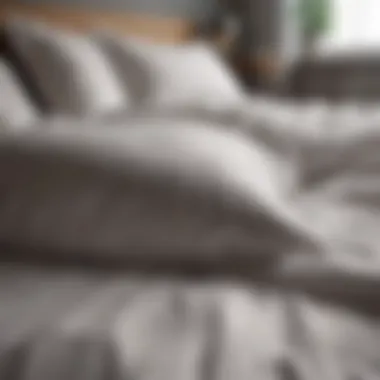Top Duvet Covers for Hot Weather Comfort


Intro
Selecting a duvet cover during warmer months is crucial for ensuring a restful sleep experience. The proper cover does not only improve comfort but also elevates the aesthetic of one’s bedroom. This written piece provides guidance on notable factors such as materials, designs, and features suited for hot climates. Understanding these elements can aid in creating a more enjoyable sleeping environment.
A good duvet cover integrates breathability and moisture-wicking properties, making it ideal for warmer weather. Materials like cotton, linen, and lightweight blends play a vital role in regulating temperature and enhancing airflow. Furthermore, aesthetics matter as visually appealing designs contribute positively to one’s sleeping space.
In addition to exploring options that meet these criteria, maintenance and care cannot be overlooked. Proper cleaning and storage practices prolong the life of a duvet cover, ensuring continued comfort and style. This article aims to equip homeowners, interior design enthusiasts, and anyone invested in creating a comfortable space with knowledge, thus enabling informed choices when selecting duvet covers suited for warm weather.
Design Inspiration
The design of such duvet covers should reflect current trends and personal preferences while ensuring functionality. A warm-weather duvet cover not only has to be comfortable but also visually pleasing.
Current Trends in Interior Design
In recent years, minimalistic yet functional designs have gained popularity. Natural materials with sustainable practices are now at the forefront. Many people prefer earth tones and organic textures, which create a serene atmosphere, aligning well with warm months.
Lightweight fabrics can complement various home styles easily.
Color Palettes That Transform Spaces
The right colors can significantly impact bedroom ambiance. Here are some effective color choices for duvet covers:
- Soft Neutrals: Shades like beige, cream, and light gray provide a calm backdrop. They create an airy feel that is especially beneficial during warmer months.
- Pastels: Light blues, soft greens, and gentle pinks add a pop of color without overwhelming the space.
- Bolder Hues: Some may opt for striking colors like coral or teal. These can serve as focal points, making a statement in a well-coordinated space.
Ultimately, the color palette should invite relaxation while contributing to a welcoming environment.
"A well-chosen duvet cover can elevate the entire room’s style and comfort, particularly in warm conditions."
With careful selection of materials and designs, duvet covers can enhance both bedroom aesthetics and overall comfort, making them essential for warm-weather living.
Understanding Duvet Covers
Definition and Purpose
A duvet cover is essentially a protective layer that encases a duvet. It serves multiple purposes, primarily to shield the duvet from dirt, dust, and spills. Additionally, it allows for easy cleaning and maintenance, as washing a duvet cover is simpler than washing an entire duvet. Duvet covers also offer a chance to change the look and feel of a bedroom without needing to buy new bedding.
Components of a Duvet System
In understanding duvet covers, it is essential to know the components of a duvet system. The system typically involves three main parts:
Duvet
A duvet is a type of blanket, filled with materials like feathers, down, or synthetic fibers, providing warmth. Its main characteristic is its thickness, which contributes to its insulating properties. Duvets are popular because they offer versatile warmth; they can be lightweight for warmer seasons or heavier for cooler temperatures. The unique feature of a duvet is that it simply requires a cover; without it, it can be cumbersome to clean. Therefore, investing in a quality duvet along with an appropriate cover is a wise choice in this article context.
Duvet Cover
The duvet cover serves as the outer layer of the duvet. It is typically made from fabrics like cotton, linen, or a blend, which influence breathability and comfort. The key characteristic of a duvet cover is its variety, available in numerous styles and colors, thus allowing for personal expression in interior design. The unique feature of a duvet cover is its ability to transform the look of the bedding easily. Additionally, while it enhances comfort, it also facilitates temperature regulation, critical for warm weather.
Bed Sheet
A bed sheet is another integral component of the bedding system. It sits beneath the duvet and provides a soft surface to sleep on. Bed sheets come in various materials, such as cotton, polyester, or jersey knit, and their design directly affects comfort. The key characteristic of a bed sheet is its fit; it needs to be adequately sized for the mattress to prevent slipping. The unique feature of a bed sheet is its direct contact with the sleeper's skin, impacting comfort levels significantly. Thus, selecting a breathable and soft sheet is essential when aiming for warmth management during the hotter months.


Importance of Choosing the Right Duvet Cover
Selecting the appropriate duvet cover in warm weather is not just a matter of aesthetics; it significantly influences your sleep quality and overall comfort. The right duvet cover can enhance your sleeping experience by regulating temperature, minimizing moisture retention, and contributing to a more restful night. Given that sleep is crucial for health and well-being, understanding the factors involved in choosing a duvet cover becomes essential for homeowners and those seeking to optimize their living environments.
Impact on Sleep Quality
Sleep quality can be impacted by numerous factors. Among them, the choice of duvet cover plays a formidable role. When temperatures rise, heavy or poorly ventilated covers can lead to discomfort, resulting in restless nights. Light and breathable fabrics allow for better airflow, reducing the likelihood of overheating.
Lightweight duvet covers made from high-quality materials help maintain a comfortable microclimate around your body while you sleep. Cotton and linen options are particularly effective in absorbing sweat, making them favorable for humid conditions. The texture of the fabric also affects sleep quality; softer materials tend to provide a more pleasant touch, which may encourage deeper sleep.
- Quality Materials Matter: Opting for natural fibers like cotton or linen promotes airflow.
- Texture Affects Comfort: Softer duvet covers contribute to a soothing sleep environment.
Temperature Regulation
Weather can change dramatically, but your sleep environment should remain stable and comfortable. Temperature regulation is a pivotal aspect of a duvet cover. During warm seasons, effective moisture-wicking capabilities are essential. They ensure that any perspiration does not linger against your skin, thus enhancing comfort throughout the night.
Fabrics like bamboo have the added benefit of being both breathable and moisture-wicking. This means that they actively work to keep you cool while drawing moisture away from your body. Furthermore, a duvet cover designed for warm conditions should be lightweight yet durable, capable of withstanding multiple washes without losing its functional benefits.
"The right duvet cover can transform your sleeping experience, ensuring that you wake up refreshed and ready for the day."
In summary, the selection of a duvet cover suitable for warm weather involves a careful consideration of fabric type, breathability, and moisture management. A thoughtful choice directly enhances sleep quality and comfort, allowing you to enjoy restful nights even during the hottest months.
Optimal Materials for Warm Weather
Choosing the right materials for duvet covers is crucial when it comes to warm weather. The materials have a direct impact on comfort, breathability, and moisture management. Each material has its unique benefits and considerations, which can significantly influence the quality of sleep, especially in hotter climates. This section will explore three of the most suitable materials for warm weather duvet covers: cotton, linen, and bamboo. Understanding these materials helps homeowners and interior design enthusiasts make informed decisions that enhance the overall sleeping experience.
Cotton
Breathability
Breathability in cotton duvet covers refers to their ability to allow air to circulate, which is essential for maintaining a comfortable sleeping environment. This characteristic makes cotton a popular choice for warm weather duvet covers. A highly breathable fabric helps in regulating body temperature, preventing overheating during sleep. The key feature of breathable cotton is its natural fiber composition that promotes airflow.
The advantages of breathable cotton are clear: it allows sweat to evaporate, reducing discomfort at night. However, some cotton types may trap heat more than others, so it's important to choose lighter, aptly woven cotton for optimal results.
Softness
Softness is another defining aspect of cotton duvet covers. Soft cotton provides a comfortable surface to lie on, contributing to a better night’s sleep. Its gentle texture is appealing to many, making it a favored material in the bedroom. Soft cotton covers feel refreshing against the skin, particularly in warmer climates.
While softness brings comfort, it is essential to consider the thickness of the fabric. This aspect might influence the durability of the cover over time. Thinner, softer cotton may wear out faster than heavier versions, so there is a trade-off between immediate comfort and long-term use.
Linen
Natural Cooling
Linen is well-known for its natural cooling properties. This fabric is derived from the flax plant and has the ability to stay cool even in high temperatures. The loose weave of linen encourages airflow and reduces heat buildup, making it an excellent choice for warm weather. Its natural fibers also absorb moisture, aiding in comfort.
Natural cooling features of linen are beneficial as they promote a restful sleep without waking up feeling overheated. Homeowners who value sustainability will appreciate that linen is made from natural materials and can offer a cooling effect that synthetic fabrics typically lack.
Durability
Durability is a significant quality of linen. Unlike cotton, linen tends to become softer with each wash while maintaining its strength. Its fibers are robust, making it resistant to wear and tear. This characteristic is advantageous for those seeking long-lasting duvet covers that withstand regular use.
However, one consideration is that linen may require more care when washing. While it is durable, it can wrinkle easily, which may not appeal to everyone. Careful handling is advised to preserve its quality over time.


Bamboo
Moisture-Wicking
Bamboo materials offer excellent moisture-wicking properties. This means bamboo duvet covers draw moisture away from the body, keeping the sleeper dry. This aspect is particularly useful during hot nights when sweat is common. The moisture-wicking nature of bamboo fibers helps regulate temperature, ensuring comfort throughout the night.
One interesting feature is that bamboo is naturally breathable, further enhancing its moisture-management capabilities. While the benefits are clear, potential downsides include availability and a higher price point compared to more common materials.
Hypoallergenic
Hypoallergenic properties of bamboo also add to its appeal, especially for allergy sufferers. This material is less likely to harbor dust mites, mold, and other allergens. Its growth process, free from harmful chemicals, ensures that the fabric remains clean and safe for sensitive skin.
The hypoallergenic aspect is significant for maintaining an allergen-free sleeping environment, which can enhance overall health. However, consumers should be aware that not all bamboo products are created equal. It is essential to verify sourcing practices to ensure the quality and safety of the bamboo duvet cover.
Design Considerations
Design considerations play a crucial role in selecting a duvet cover suitable for warm weather. While functionality remains the primary concern, the aesthetic aspects cannot be overlooked. The interplay between design, materials, and personal preferences creates an environment that influences comfort and satisfaction. Homeowners should take care to choose elements that promote a cooler sleeping space while still aligning with their style.
The color palette can significantly affect how a fabric feels. Lighter shades often induce a cooler sensation, making them an excellent choice for hot climates. Colors like whites, soft blues, and pale greens are excellent options, as they can reflect natural light and make the room feel airier. Additionally, using patterns with these colors can enhance this effect, contributing to a refreshing ambiance.
When thinking about style, consider how duvet covers might coordinate with other bedroom elements. This synergy can make a remarkable difference in personalizing your space. A well-chosen duvet cover not only provides comfort but also serves as a focal point in bedroom design.
Moreover, the choice between lightweight and heavyweight fabrics is essential in warm weather considerations. Lighter materials naturally offer more breathability, promoting comfort during warm nights.
Regardless if you prioritize design or function, finding the right balance is important. A thoughtfully selected duvet cover communicates individual taste while ensuring optimal comfort.
Patterns and Colors for Summer
Patterns and colors serve distinct purposes in duvet cover design, especially for warm weather. Choosing the right combination can enhance the overall ambiance of your bedroom.
- Light Colors: These shades help in reflecting sunlight. Whites, creams, and light pastels can create a serene atmosphere, conducive to relaxation.
- Soft Patterns: Subtle florals or simple geometric designs can add visual interest without overwhelming the room. These designs maintain a sense of calm and pair well with various decor styles.
- Avoid Dark Hues: Darker colors absorb heat, making them less suitable for warm weather. It is advisable to steer clear of rich browns or deep reds that can make the space feel warmer.
Overall, selecting patterns and colors that evoke a cool and refreshing vibe can positively impact your sleep experience during warmer months.
Lightweight Versus Heavyweight Covers
The debate between lightweight and heavyweight duvet covers is pertinent when considering comfort in hot weather. Each option has its unique advantages.
Lightweight covers provide higher breathability. They allow for increased airflow, which is a crucial factor when temperatures rise. Light covers typically use materials like cotton or linen that facilitate moisture wicking, helping to keep the sleeping environment dry.
On the other hand, heavyweight covers may offer added warmth but can feel suffocating in hot weather. These are often more luxurious and plush but are better suited for colder months. When the goal is staying cool, it is wise to opt for lighter options that do not weigh down the user.
Breathability and Moisture Management
Breathability and moisture management play vital roles when selecting a duvet cover, especially in warm weather. The primary goal in the warmer months is to maintain a comfortable sleep environment. A duvet cover that lacks breathability may trap heat and moisture, leading to discomfort and disrupted sleep patterns. In addition, good moisture management ensures that any perspiration is effectively absorbed and evaporated, which can enhance the overall sleeping experience.
A duvet cover designed for warm conditions typically features materials and construction techniques that promote airflow. This support the body's natural processes in regulating temperature, helping you feel cool and comfortable throughout the night. Therefore, understanding the key aspects of breathability and moisture management can significantly impact your choice of bedding.
Technical Features to Look For
When considering breathability and moisture management, it's essential to focus on certain technical features. Here are some important aspects to consider:


- Fabric Construction: Look for duvet covers made from tightly woven fabrics which enable air to circulate while preventing heat retention. Examples include percale cotton and linen.
- Moisture-Wicking Properties: Fabrics that wick moisture away from the body can significantly enhance comfort. Options like bamboo blends offer excellent moisture management.
- Thread Count: A lower thread count often indicates a more breathable fabric. Higher thread counts can lead to denser fabric, which may not allow for adequate airflow.
- Surface Finish: Consider options with special finishes that promote breathability. Products treated for enhanced moisture control can also improve comfort levels.
Airflow and Temperature Control
Airflow is crucial for maintaining an optimal sleeping environment in warmer weather. Duvet covers that promote airflow help to regulate temperature and prevent overheating. Several factors contribute to airflow and temperature control in duvet covers:
- Open Weave Design: Fabrics engineered with an open weave allow air to flow easily, which encourages a cooling effect. This type of design is preferable in hotter climates.
- Layering Options: Choosing a duvet cover that allows for easy layering with lightweight bedding can further manage temperature. This ensures you can adapt your sleeping setup based on how warm it gets during the night.
- Ventilation: Some duvet covers come with ventilation features like mesh or breathable panels that enhance airflow. These details help maintain the balance between comfort and temperature regulation.
- Active Adjust Technology: Some brands offer covers that utilize advanced technology to adjust to body temperature dynamically, ensuring heat is released when necessary. This innovation is an attractive feature for those living in fluctuating climates.
In summary, prioritizing breathable and moisture-managing duvet covers greatly enhances your sleep experience in warm weather. Take time to research technical features, airflow capabilities, and the specific materials utilized. This knowledge empowers you to choose a duvet cover that not only looks aesthetic but also meets the essential needs for comfort and rest.
Popular Brands for Warm Weather Duvet Covers
Choosing the right brand for your duvet cover can significantly impact your comfort during warmer months. The quality and design of duvet covers vary widely across different manufacturers. Some brands prioritize breathability and lightweight materials, while others focus on style or affordability. Understanding these differences is essential for making an informed choice that enhances your sleeping experience in hot weather.
When selecting a duvet cover, consider elements such as fabric quality, durability, and customer reviews. Look for brands that specialize in materials suitable for warm weather like lightweight cotton, linen, or bamboo. Additionally, aesthetic appeal plays a role; the right colors or patterns can brighten your space and contribute to a cooler ambiance.
High-End Options
High-end duvet cover brands often utilize premium materials and advanced textile technologies. These brands are known for their attention to detail and durability, which make them a worthwhile investment.
For instance, Brooklinen offers duvet covers made from high-quality cotton. Their fabric is known for its softness and breathability, suited for warm climates. Another notable brand is Parachute, which features a selection of linen duvet covers that are both stylish and functional. Their lightweight options keep air flowing, making sleep comfortable. Coyuchi is another high-end option, emphasizing organic materials and sustainability, attracting eco-conscious consumers.
While these brands can be more expensive, they often provide exceptional quality and long-lasting product life, supporting the value of investing in a better sleep experience.
Affordable Choices
There are numerous affordable options for duvet covers that do not sacrifice quality or comfort. Brands like IKEA and Target offer a range of stylish duvet covers made from breathable materials at accessible prices. Their products allow homeowners to invest in aesthetically pleasing options that are ideal for warm weather without breaking the bank.
Amazon Basics also provides budget-friendly selections that ensure comfortable sleep. Their duvet covers are designed with durability and simplicity in mind, appealing to many homeowners looking for value. Furthermore, Beddy's has unique designs that simplify bed-making while ensuring a pleasant sleeping environment.
The reasonable pricing of these brands makes them suitable for anyone seeking a comfortable duvet cover to suit the summer heat.
Care and Maintenance
Understanding the care and maintenance of duvet covers cannot be overlooked, especially when it comes to warm weather. A well-maintained duvet cover not only ensures your sleeping environment stays fresh but also extends the life of the cover, making your investment worthwhile. Proper care helps maintain the integrity of the fabric, prevents damage, and ultimately enhances the overall sleep experience.
Washing Instructions
Regular washing of your duvet cover is essential for hygiene and comfort. Not all covers are created equal, so follow these guidelines for effective cleaning:
- Read the Label: Before washing, check the care label for specific instructions related to your duvet cover material. This may include recommended washing temperatures and drying methods.
- Use Mild Detergents: Choose a mild, eco-friendly detergent to prevent fabric breakdown. Harsh chemicals can harm the soft texture and breathability of the cover.
- Wash in Cold or Warm Water: For most materials like cotton and linen, using cold or warm water is advisable. This helps to prevent shrinking and fading.
- Separate Colors: Always wash similar colors together to avoid dye transfer.
- Gentle Cycle: Select a gentle cycle on your washing machine. This reduces wear and tear on the fabric.
- Drying: Air drying is the best option. If using a dryer, opt for a low heat setting to avoid damaging the fabric. Avoid over-drying as this can lead to wrinkles and shrinkage.
Storage Tips
Proper storage of your duvet cover when not in use is equally important for its longevity. Here are some useful tips:
- Clean Before Storing: Always wash the duvet cover before storing it. Stains can set over time, making them harder to remove later.
- Store in a Cool, Dry Place: Humidity can lead to mold and mildew, so choose a dry area for storage.
- Use Breathable Storage Bags: Avoid plastic bags that can trap moisture. Instead, opt for cotton or linen bags that allow air circulation.
- Avoid Direct Sunlight: Prolonged exposure to sunlight can fade colors and weaken fibers. Store the duvet cover in a shaded location.
- Keep Away from Pests: Ensure the storage area is free from pests. Wrapping the duvet cover gently in tissue paper can provide an extra layer of protection.
Keeping your duvet cover clean and well-stored not only enhances its aesthetic appeal but also plays a significant role in maintaining a healthy sleep environment.
By following these care and maintenance steps, you can ensure that your duvet cover remains an integral part of your comfortable sleeping arrangement, especially during warmer nights.
Closure
Choosing the right duvet cover for warm weather is not just a matter of aesthetics. It plays a crucial role in enhancing sleep quality and personal comfort. This article has explored various aspects essential to finding that perfect cover, guiding you through the process step by step. Understandably, warm weather brings challenges, including temperature regulation and breathability. A suitable duvet cover helps address these concerns and transforms your sleeping environment.
Recap of Key Points
- Material Matters: Opt for fabrics like cotton, linen, and bamboo that allow for maximum airflow and moisture management. These materials do not trap heat, allowing for a cool night’s rest.
- Design Considerations: Light colors and breathable designs are particularly effective for warm climates. Avoid heavyweight covers that can lead to discomfort.
- Moisture Management: Select duvet covers that have moisture-wicking capabilities. Keeping sweat away from the skin contributes to a more pleasant sleeping experience.
- Care and Maintenance: Regular washing and proper storage are essential for longevity. Pay attention to washing instructions to maintain the integrity of the fabric.



